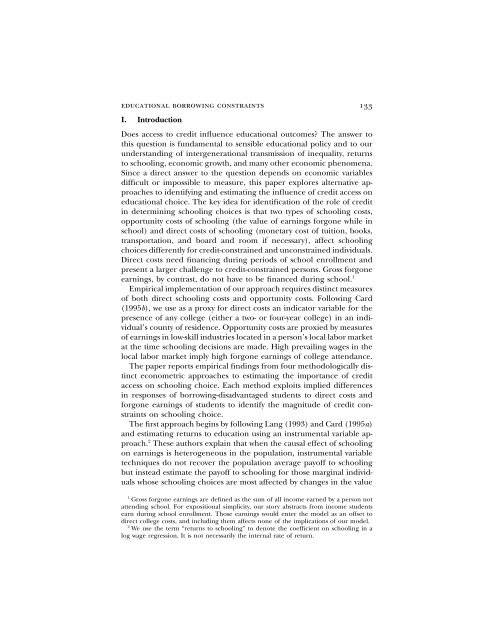Estimation of Educational Borrowing Constraints Using Returns to ...
Estimation of Educational Borrowing Constraints Using Returns to ...
Estimation of Educational Borrowing Constraints Using Returns to ...
- No tags were found...
You also want an ePaper? Increase the reach of your titles
YUMPU automatically turns print PDFs into web optimized ePapers that Google loves.
educational borrowing constraints 133<br />
I. Introduction<br />
Does access <strong>to</strong> credit influence educational outcomes The answer <strong>to</strong><br />
this question is fundamental <strong>to</strong> sensible educational policy and <strong>to</strong> our<br />
understanding <strong>of</strong> intergenerational transmission <strong>of</strong> inequality, returns<br />
<strong>to</strong> schooling, economic growth, and many other economic phenomena.<br />
Since a direct answer <strong>to</strong> the question depends on economic variables<br />
difficult or impossible <strong>to</strong> measure, this paper explores alternative approaches<br />
<strong>to</strong> identifying and estimating the influence <strong>of</strong> credit access on<br />
educational choice. The key idea for identification <strong>of</strong> the role <strong>of</strong> credit<br />
in determining schooling choices is that two types <strong>of</strong> schooling costs,<br />
opportunity costs <strong>of</strong> schooling (the value <strong>of</strong> earnings forgone while in<br />
school) and direct costs <strong>of</strong> schooling (monetary cost <strong>of</strong> tuition, books,<br />
transportation, and board and room if necessary), affect schooling<br />
choices differently for credit-constrained and unconstrained individuals.<br />
Direct costs need financing during periods <strong>of</strong> school enrollment and<br />
present a larger challenge <strong>to</strong> credit-constrained persons. Gross forgone<br />
earnings, by contrast, do not have <strong>to</strong> be financed during school. 1<br />
Empirical implementation <strong>of</strong> our approach requires distinct measures<br />
<strong>of</strong> both direct schooling costs and opportunity costs. Following Card<br />
(1995b), we use as a proxy for direct costs an indica<strong>to</strong>r variable for the<br />
presence <strong>of</strong> any college (either a two- or four-year college) in an individual’s<br />
county <strong>of</strong> residence. Opportunity costs are proxied by measures<br />
<strong>of</strong> earnings in low-skill industries located in a person’s local labor market<br />
at the time schooling decisions are made. High prevailing wages in the<br />
local labor market imply high forgone earnings <strong>of</strong> college attendance.<br />
The paper reports empirical findings from four methodologically distinct<br />
econometric approaches <strong>to</strong> estimating the importance <strong>of</strong> credit<br />
access on schooling choice. Each method exploits implied differences<br />
in responses <strong>of</strong> borrowing-disadvantaged students <strong>to</strong> direct costs and<br />
forgone earnings <strong>of</strong> students <strong>to</strong> identify the magnitude <strong>of</strong> credit constraints<br />
on schooling choice.<br />
The first approach begins by following Lang (1993) and Card (1995a)<br />
and estimating returns <strong>to</strong> education using an instrumental variable approach.<br />
2 These authors explain that when the causal effect <strong>of</strong> schooling<br />
on earnings is heterogeneous in the population, instrumental variable<br />
techniques do not recover the population average pay<strong>of</strong>f <strong>to</strong> schooling<br />
but instead estimate the pay<strong>of</strong>f <strong>to</strong> schooling for those marginal individuals<br />
whose schooling choices are most affected by changes in the value<br />
1<br />
Gross forgone earnings are defined as the sum <strong>of</strong> all income earned by a person not<br />
attending school. For expositional simplicity, our s<strong>to</strong>ry abstracts from income students<br />
earn during school enrollment. Those earnings would enter the model as an <strong>of</strong>fset <strong>to</strong><br />
direct college costs, and including them affects none <strong>of</strong> the implications <strong>of</strong> our model.<br />
2<br />
We use the term “returns <strong>to</strong> schooling” <strong>to</strong> denote the coefficient on schooling in a<br />
log wage regression. It is not necessarily the internal rate <strong>of</strong> return.

















